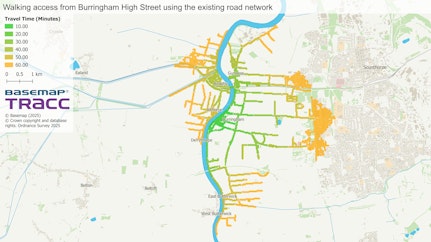


Whether its a river, a busy road, or a railway track, there can be many barriers to journeys, particularly when walking or wheeling. Infrastructure which overcomes these barriers can not only reduce travel times but also link people with new destinations such as jobs, schools and healthcare as well as connecting them to key transport interchanges. This can be done through the use of bridges, tunnels or the addition of crossings.

With TRACC we looked at how adding infrastructure to reduce these barriers can help open up wider accessibility in an area. For this example we focused on the villages of Burringham and Althorpe in North Lincolnshire. These two villages are separated by the River Trent and currently require a 40-minute walk to get between the two villages despite being located only around 100m apart.
By introducing a new footbridge in TRACC to better connect the two villages we were able to analyse the impact of this on both walking and public transport accessibility. The footbridge increases the number of residents who can access Burringham within a 30-minute walk by 112%, particularly residents in areas south of Keadby Bridge. Keadby Bridge is located around 1km north of the villages, near the village of Keadby. The bridge allows for rail, car and pedestrian travel, with a segregated footbridge on its northern side.
Burringham is currently served by a single bus service which connects it to Scunthorpe with services running twice a day in each direction on weekdays. Althorpe is better served with 6 services per day on weekdays as of 7th April 2025, connecting residents to areas such as Epworth, Belton and Doncaster. This difference in frequency means that public transport access also showed a substantial improvement, particularly for Burringham due to connecting residents to the higher frequency bus services in Althorpe. Connections to this bus service allows twice as many North Lincolnshire residents to access Burringham within 60 minutes by public transport.

Public transport access is of even greater importance due to the low pavement presence in the areas surrounding Althorpe and Burringham, making longer walking journeys to the west less safe due to the lack of segregation between pedestrians and vehicles.
Watch our latest video for a closer look at the results in TRACC.
If you would like to learn more about how TRACC can help you analyse the impact of new infrastructure, please get in touch.